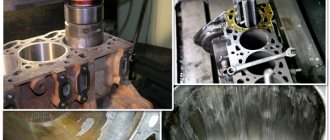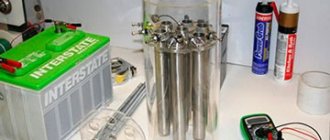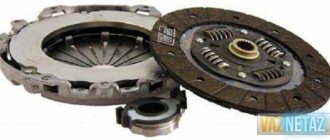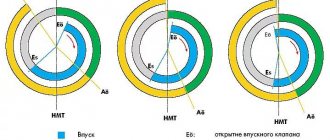Definition
Direct flow (or direct-flow vehicle exhaust system) is a system for removing exhaust gases from an engine, which does not have a large number of exhaust suppression and purification chambers (often only one “flame arrester” and one resonator are used), due to which the gases flow almost unhindered, without meeting There is virtually no resistance along the way. Moreover, they try to make the outlet pipe straight, without unnecessary corners and branches, in order to further reduce the resistance of the structure - hence the name “forward flow”.
What do direct flows provide?
If you install a new direct-flow muffler instead of an old, stock one that is out of order, then what advantages will you be able to achieve? Let's consider two situations when you linearly dismantle the old muffler and install a sports version in its place. The second situation will concern the complete replacement of the entire exhaust tract with a sports version.
And so, you install only a direct-flow muffler, in this case you get:
change in the sound of the engine with a predominance of bass, noble notes. There is no need to be afraid that the sound of your machine will become too loud. If you buy a spare part from a reliable company, you can be sure that the existing standards for noise levels from your car will be met;
improving the appearance of the rear of the car. It is not without reason that direct flows are used not only for tuning, but also for car styling. Improved appearance can be achieved through a designer exhaust pipe attachment. This attachment is made from polished stainless steel, and it looks really stylish (see video).
Is there an increase in power in this case? In practice, many car owners who have installed a direct-flow muffler and compared its performance with the performance of a stock factory muffler say that the increase in power is felt at certain engine speeds. For example, when accelerating.
However, in the general case, we are still not talking about a significant increase in useful power for a car from direct flow alone. The fact is that direct-flow or sports mufflers, as well as other elements of a direct-flow exhaust system, optimize the removal of exhaust gases from the combustion chambers (through the exhaust valve and beyond). In such systems, the minimum is counterflow - back pressure or resistance to the movement of exhaust gases in the exhaust system.
So what does a direct-flow exhaust system give?
I will try to explain in simple words. Let's remember how the engine works. One of the important cycles is the removal of exhaust gases. This happens through a special device called a muffler, where they pass through a flame arrester, then a catalyst, through several resonators (parts of the muffler) and then all exit through the exhaust pipe. Already clean and without unnecessary noise, sometimes almost inaudible, especially on expensive foreign cars, where there are more muffling elements than on budget cars. This is the classic system of “silencing” and processing gases from the engine. Almost all modern cars are equipped with it, you’ve probably heard about EURO 4, EURO 5 standards, and soon there will be a sixth generation - I repeat, all for the sake of the ECOLOGY.
However, have you ever wondered how much force the engine needs to push the exhaust through this system? This results in increased consumption and loss of power, because you need to spend energy removing exhaust gases! This is the other side of the coin. Try inflating a balloon through a regular straw - it’s easy, of course YES! And then try to stuff a bandage there and also inflate a balloon - you’ll spend a lot more effort!
The direct-flow exhaust system throws out all kinds of catalysts and muffling elements from its structure. BUT NOT ALL! AS MANY THINK! The exhaust after the engine meets a flame arrester, which prevents excess hot gases from entering the system; there may also be “resonators”, but with reduced resistance. Again, tuning studios try to make this muffler straight, without bends or bends, so that the flow of exhaust gases goes straight, with minimal resistance (that is, it is a kind of “empty tube” and ball).
The flame arrester and resonators in this system are primitive, without complex partitions and sections, the main task is to extinguish excess hot gas and reduce sounds from the exhaust, but in no case, not to delay the flow. Thus, improved gas removal is achieved, and accordingly the engine does not waste power on their removal; if compared with a conventional engine, it actually has more power. This is what tuners and all kinds of racers use.
What is a straight-through muffler
Many people have sometimes noticed how tuned cars roar along the highway. What gives them extra power, a deep roar and instant acceleration? Improved exhaust system, namely the installation of a direct-flow muffler. Do not underestimate the exhaust system, because by changing its configuration, you can “play” with the power of the power unit without spending money on complex and expensive tuning of the gearbox or engine. You can make a direct flow in the garage, having a small set of tools with you; installing it is also not particularly difficult.
What is a direct-flow muffler, how does it differ from a regular one? This is a muffler in which the so-called “labyrinth” system has been removed in one of the resonators, due to which the exhaust gases escape faster than on a standard muffler. Installing direct flow is more than justified if the car has a tuned power unit. A more powerful engine produces more exhaust, so it is very important that the exhaust system does not “suffocate” it.
A few words about the exhaust manifold
In order to further maximize power, the engine's exhaust manifold (the initial part of the muffler) is also changed to a direct-flow one. Usually they make the same outlet (pipes) from each of the cylinders, which are then combined into one large one or two large ones. Thus, the pressure does not “superpose” on each other, but is effectively discharged into one large (subsequent) pipe. There will be a separate (large) article about the collector, so subscribe to updates.
Why does forward flow use a large pipe?
And here everything is simple - the larger the pipe, the less resistance the gases encounter. For example, for some VAZ models, the optimal diameter for the forward flow (base pipe) is 51 mm.
However, towards the end, the direct-flow muffler expands much, but this is not the main pipe, it is a resonator. The thing is that the farther the resonator is from the engine, the more efficiently it works, because at the end the gas pressure drops significantly, which means there will not be much resistance. In fact, at the end it is needed to dampen the sound.
The difference between a direct-flow muffler and a conventional one
A straight-through muffler is the same muffler, but without baffles to dampen low-frequency noise. It may contain mineral wool padding, which dampens high-frequency noise but allows low-frequency noise to pass through.
The diagram shows that the direct-flow muffler does not have transverse partitions. The standard muffler consists of a rather complex system of pipes and grilles in which noise is dampened. Parts of the exhaust system on a modern car also include a lambda probe, a catalytic converter, and an exhaust gas temperature sensor. Thus, a standard muffler compared to a forward flow muffler is a slightly more complex system. The standard muffler consists of a complex system of pipes and grilles
Direct-flow muffler device
For proper tuning of the exhaust system, it is advisable to install a different, improved exhaust manifold in combination with forward flow, remove the catalyst and install a receiving pipe of increased diameter. After all, in a tuned exhaust system, all obstacles that stand in the way of exhaust gases have been removed.
A straight-through muffler is made so that its throughput is higher than that of a standard muffler, and it more freely removes exhaust gases from the engine. As a result of such tuning, cylinder purging improves, less carbon deposits on the pistons and valves, which, in turn, increases the life of the power unit. Its power increases by about 15%.
A related factor is a slight deterioration in noise performance compared to the standard muffler. The straight-through muffler has a harsh roar that can attract the attention of the traffic police, cause a fine, or provoke the anger of neighbors when a tuned car revs under their windows early in the morning.
When installing an improved exhaust system, these factors should also be taken into account, otherwise tuning may cause pointless costs in the future. The absence of internal partitions and noise-absorbing padding makes direct flow relatively simple to manufacture.
Standard and direct-flow mufflers with remote “labyrinth” and noise absorbers
What does direct flow give?
A significant improvement in the power performance of a car with the installation of a direct-flow muffler occurs when the power unit is fully operational, maintains normal compression, is little worn, and even better - if any of its components have been modified. Thus, forward flow will increase power if the cylinder head, the intake system have been tuned, or the cylinder block itself has been bored to a larger volume. If the car owner has not yet taken on serious modifications to the engine, but wants to spend money on exhaust tuning, then by doing so he will still increase the power of the power unit, receiving in addition a bass rumble, making the car a little more dynamic.
Why do direct flows roar and is it legal?
It's all about the design, or more precisely, the absence of damping elements, because they are thrown out for the sake of power - that's why it "roars". The exhaust from the engine is not only harmful, but also very “noisy” - try removing the muffler and starting the car, your ears will probably get blocked from the roar! The muffler, after all, got its name from the word “muffler”, to make the car almost silent, and only later also environmentally friendly.
Here's a short video of how it can roar.
Many such tuning elements (direct flows) are prohibited by law. By law, the permitted noise level should not exceed 100 dB; an ordinary car can easily accommodate this.
But not direct flow - after all, the noise level directly depends on the increase in power - that is, if you choke the engine with resonators, it will not be heard, but the effect from such a direct-flow muffler will be minimal.
Now, according to the law, you can easily get a fine of 300 - 500 rubles. Also, the car may be subject to a fine for being parked as a car not intended for use (previously there was a fine of 100 rubles and the license plates would be removed).
SDA - The permissible level of external noise exceeds the values established by GOST R 52231-2004. (clause 6.5 introduced by Decree of the Government of the Russian Federation of December 14, 2005 N 767)
A short instructive video, be sure to watch it.
Features of the structure of a conventional muffler
How is the sound wave damped in a regular stock muffler? Inside the can it is divided into partitions, chambers, and reflectors. It resembles a small labyrinth where the sound wave is broken up, reflected and re-reflected, dampened, compensated, divided and reduced in energy. The output we get is not a series of very loud explosions, but a quiet “rumbling”.
In a conventional muffler, not only a sound wave passes through all these labyrinths, but also a flow of exhaust gases. And there he experiences strong resistance, because... cannot move freely. It is this resistance that creates the back pressure of the exhaust gases, which is called “counterflow”.
The negative effect of this counterflow is that it makes it difficult to free the combustion chambers from exhaust gases. To compensate for the backflow pressure, engine work is wasted. If the level of back pressure is minimized, or even reduced to zero, then the engine will not waste effort on overcoming the countercurrent, which means its useful power will increase.
For these purposes, a direct-flow sports muffler was developed. It must solve two problems at once:
correctly and adequately dampen the sound wave generated by the explosion of the fuel mixture in the combustion chamber;
Reduce the countercurrent effect to a minimum.
How it copes with its function will be discussed in a little more detail when considering its structure.
Can I do it myself?
Of course you can, but it’s not as easy as it seems. I would like to note that if you install this type of mufflers, then it is better to buy special tuning ones, fortunately there are now a lot of them on the market, for almost any size and model. THERE ARE EVEN MORE OR LESS “QUIET” 100 dB. But if your hands are itching, then:
1) Buy a standard muffler, or remove yours, the main thing is that it is in working condition.
2) Pipes that will be further used in modernization must be of the same diameter and have a heat-resistant material.
3) You also need to have a special heat-resistant noise absorber, usually special glass wool.
4) The standard muffler is cut, all its walls are cut out, and then all the insides are thrown out.
5) After this, we take a pipe that fits the bases on both sides, it should be slightly smaller in diameter, and weld it at the ends of the connection.
6) After this, holes are drilled in this pipe with a diameter of 6 to 8 mm.
7) After this, you need to lay sound-absorbing material around this section.
 We close and weld the case, and install it on the car. Resistance is removed - forward flow is done.
We close and weld the case, and install it on the car. Resistance is removed - forward flow is done.
Now a short video of making a forward flow
However, the disadvantages are also obvious:
— most likely, it will not last long, because the factory design has been damaged.
- Is the material of the inner tube really good?
- the gases will flow directly, and accordingly it will heat up more, this also needs to be taken into account, it is advisable not to hang it close to the body.
As you can see, there are also a lot of questions, it’s better not to be lazy and buy a “special” one, made of durable materials, for your car.
I will end here, I hope my information was useful to you! Read our AUTO SITE.
Similar news
- MPI engine
- What is a G-sensor in a DVR
- What is an electrolyte?
How to make a direct-flow muffler with your own hands
To save money on purchasing a factory direct flow, you can make a “glushak” yourself.
Moreover, constructively, this procedure is quite simple, but several nuances should be kept in mind: the muffler must be completely sealed and quickly remove the entire volume of exhaust gases from the system.
First way
The simplest direct-flow manufacturing technology is to remake a conventional muffler.
You can use the muffler that is already on your car or buy a new one.
The main thing is that the workpiece is intact and has no soot, deformations or cracks.
Video: making forward flow from a conventional muffler
https://youtube.com/watch?v=opK2mRZvQ9Y
Preparing tools
In this case you will need:
- angle grinder (grinder);
- drill;
- welding machine;
- electrodes;
- metal brushes for washing dishes.
Preparation of materials
Of course, if you are going to remake an old muffler, then first of all you need to remove it from the car and inspect it.
If the pipes are not damaged, then they can be considered a necessary material for the manufacture of direct flow.
Based on a standard muffler, a direct-flow muffler can be made without cost or time loss
Job
After preparing all the necessary tools and materials, you can start working:
- Use a grinder to cut out the upper part of the main muffler (that is, you will need to remove a piece of the casing to gain access to the insides).
- Next, all partitions and small tubes need to be removed from the body - cut out with a grinder.
- After which only one tube should remain inside the housing.
- Using a drill, you need to drill many small holes in the pipe along its entire length.
- The space inside the main muffler should be lined with metal scouring pads.
- After carrying out all these procedures, the cut piece of the body must be carefully welded back.
The straight-through muffler is ready for installation. It should be noted that this manufacturing method allows the car owner to minimize expenses, and at the same time, the “glushak” creates a really juicy and loud roar.
The main thing is to drill the maximum number of holes in the pipe
Second way
You can go another way - for example, make a direct flow from improvised elements, without using a conventional muffler.
This is a more complicated method, since you will have to carefully select each element of the new muffler.
However, if it is possible to get all the pipes and sheets of metal at an affordable price, then the method will fully justify itself.
Video: how to make a direct flow from scrap materials
Preparing the tools
Just as in the first case, you will need a grinder and a welding machine.
Necessary materials
Stainless steel sheets with a wall thickness of 1.5–2.0 mm are best suited. You can also use a cheaper analogue - for example, aluminum.
Job
Depending on the availability of materials, you can immediately find or make a pipe with holes.
The length of the pipe should not exceed 130 mm, and the diameter of the holes should not be more than 2.5 mm.
You will need to find a craftsman who will make two 42 mm flanges for attaching the pipe.
After this you need:
- Cover the pipe with holes with fireproof material - for example, basalt wool or asbestos.
- Make a muffler body from two pieces of metal.
- Place the perforated pipe inside the muffler body and fill the existing gaps with glass wool.
After which the direct-flow muffler can be considered ready for use. The method allows you to create a “glushak” of any size, but the manufacturer must be able to work with electrical equipment.
A tube with holes is the main element of the forward flow











